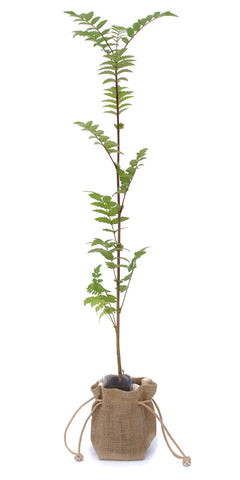Rowan Tree Facts and Information
- Latin Name: Sorbus aucuparia
- Native Words: Old Irish (luis) Scots Gaelic (caorunn) Old English () Welsh (cerdinnen) eastern Celtic ()Old Norse (regnir)
- Ogham Sign: L
- Height when Mature: 15 m (49 ft)
- Height After 10 Years: 3-4m (10-13ft)

Rowan Botanical Description:
Rowan Trees are comparatively small and grow in a compact upright shape. Rowan is sometimes called the mountain ash tree because of the similarity of its leaves to ash trees, both having many opposing finger like leaflets set along either side of a midrib (known as pinnate).
In spring, Rowan displays clusters of creamy white flowers around May, shortly after which the bright red berries begin to develop. In autumn the spectacular display of orange or red berries cover the tree and the leaves turn a brilliant flame colour. The berries cover hard seeds which require consumption by birds in order to germinate. Rowan bark is purplish grey and in winter and early spring the buds are large and purple and covered in white downy hair. For more information about the other Ancient Wisdom Trees in our range of gifts.
Rowan Natural History and Ancient Wisdom:
Rowan is the highest growing native tree in the British Isles*. Although naturally an upland tree of river valleys, pine forests moors and crags, Rowan trees are now found in all habitats and locations in the UK.
Many are cultivars or exotic varieties grown for their attractive spring flowers, bronze autumn foliage or large vibrantly coloured berries. As Rowan berries are a favourite food source of birds, and the seeds within the berries are dispersed with the birds that ate them.
In Irish myth, the ancient race of giants, the Tuatha de Dannan brought Rowan from the land of promise. The giant, who Fionn MacCool meets at the festival of Sahmain on 31 October (when we celebrate Halloween) when he travels into the Underworld throws Rowan on the fire burning in the Chamber of the dead to prevent the dead from rising.
Rowan trees were planted in graveyards with a similar purpose in mind. It is now believed that the English word rowan derived from the Norse regnir when Norse settlers arrived in eastern Britain. The Norse alphabet known as runes were carved on to Rowan wood; hence the similarity rowan/rune; “rune wood”.
Rowan is also known as the quicken-tree, which is a corruption of “witchen tree”, as it was planted near homesteads and even in churchyards to protect against witches. Scottish crofters believed that planting a rowan would keep evil spirits away; next to abandoned crofts, rowans still grow.
On the Isle of Man, Rowan twigs were placed in doorways and boughs carried at Beltaine**. This last fact points to Rowans second association in folklore: rejuvenation. In Irish myth, the salmon of knowledge eats rowan berries falling into the stream in order to keep young. * Juniper (Juniperus communis) grows in a similar environment and although technically a native British evergreen tree, is low growing and has the appearance of a shrub. **Beltaine the Celtic festival of renewal (May 1)

Rowan Place Names in the UK:
- Meall nan Chaorunnaich (Perthshire)
- Beinn Chaorunnn (Inverness-shire)
Wildlife Rating
Rowan berries are an excellent source of food for birds in winter and trees can often be seen crowded with birds in winter. The red fruit is loved by thrushes such as Redwing and Blackbirds. An uncommon winter visitor from Scandinavia, the striking Waxwing, seeks out rowans to feed on and flocks of 100 in a single tree can be seen.
Rowan Good Points / Bad Points:
Ideally favours a light well-drained soil. Very hardy. Its berries and foliage add a wonderful colour to the garden, and its slim compact nature means it doesn’t take up much space.
Buy a Rowan Tree
Tree2mydoor is an award-winning tree gifts company that has been supplying people around the UK and Ireland with long-lasting, meaningful tree gifts.
Send a Rowan Tree Gift for a birthday, anniversary or memorial and it will be lovingly appreciated for years to come.



































































